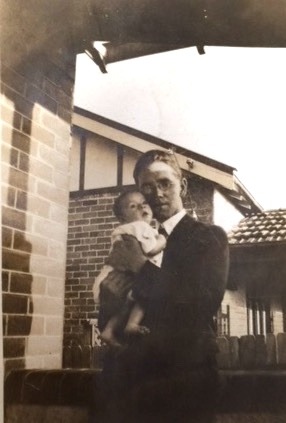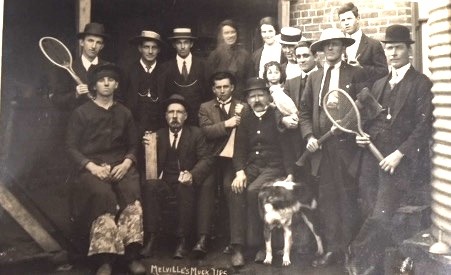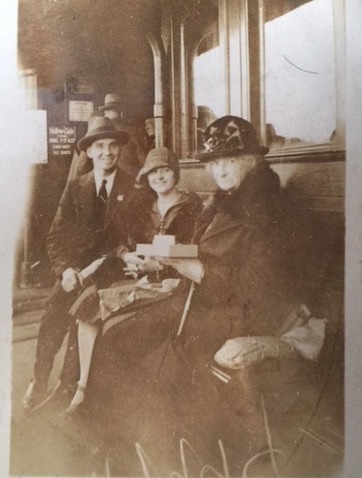This is Stewart Robert Melville’s reflection on his life in Concord. The photos and story were given to the City of Canada Bay Heritage Society by his family, and it forms an important part of the history of Canada Bay. It is in his own words with only a few editorial changes to assist with the flow of the narrative.
For a long time, I have thought that I should record in some ways the events of my life so that perhaps my children would at some time read and understand the events and feelings that I had experienced, which culminated in the person I am. At the age of 69 when I begin to write this saga, there were many events that shaped who I am. I am not always so sure of the exact timing of these events, but I will try to research the event dates to give the readers some sense of continuity.

Although I do not really remember the event, I was born at a private hospital in Burwood Sydney, NSW on the 4th of October 1932 and came into a world and a home created by my mother, Florence Victoria and father Kenneth Stewart, at 17 Warwick St, Central Concord. It was a dark brick home with stucco finish panels which were painted white. The front door was on the right hand side and there was a side entrance with a double lattice gate which led to the large rear yard. At the rear door there was a ramp which we went down, crossing the lawn, which was surrounded by flower gardens. Mum and Dad were purchasing the house from Mr Horseful a former boss of Kenneth’s at Anthony Hordens.

On the left and down the side of the lawn, separating the shed or workshop was a garden path which led to the “dunny” or toilet. This was a pan toilet, and we used pages from the telephone book and cut up newspaper for toilet paper. The “Dunny man” resplendent with apron and a flat top leather cap would come weekly and remove the pan full of faeces and urine, carrying it on his head out to the truck, which took it all away. This system was replaced later with a connection to the sewerage, but the dunny remained in its position halfway down the backyard. So, during the night we used the “potty” and it was my job to empty the potty each morning in the dunny or pan toilet. This meant that I had to take it from the house, down the ramp and along the path without spilling it or breathing in too much of the smell!

The Bush house was in the rear yard on the right hand side and was a building covered with chicken wire through which tea tree branches were woven creating a shady area. There was a concrete fishpond in which “Cleo” the goldfish lived. Under the house was an earth floor storage area, where I can remember there were educational books stored, including an “encyclopaedia” One of these are still in my library.
At the rear of the backyard was a vegetable garden in which Merrilee(my sister) and I, each had a plot. Our plots were sewn with a variety of seeds; the sunflowers were prolific growing tall with yellow heads. There were also carnations, a flower my father liked. Poppy and Marigold were among the seeds to be sown from the Yates variety packs. There were artichokes, chokos, pumpkins and potatoes. The fruit trees were also prolific mainly plums and apples that were raided from time to time by the children along the street. On one occasion mum heard some lads come over the back fence to raid the fruit trees; they retreated when they realised, she was on to them! She was able to apply a copper stick to their “rear” as their “rear ends” hung over the top of the fence! Sometime later the front doorbell rang and when Mum opened it there was a note from the “black hand gang” saying “we’ll get you”. As far as I know they never did!
In the rear of the backyard was a garage with a double door swinging out to the paddock at the rear. We never had a car, so this garage was not used other than to store things and for us children to play in. We backed onto a large common area of land which opened onto the Parramatta River and was called Hen and Chicken Bay; there was access over the back fence. On the mud flats of the river were crab holes and I used to go crabbing, bringing home old paint tins full of crabs. In the paddock at the rear of our place was plenty of Gorse Bush (Gorse is a spiny, branched, evergreen, growing to 1–2.5 m in height. It is an introduced species now considered a weed). We could make forts and generally use our imagination to play. Another family of kids down the street were the Kellys, with whom we would have mock fights. Concord was about 8.5 miles (14km) from the centre of Sydney. In Concord we had this open freedom to enjoy our imagination.
Next door lived Mrs Shady and her partner, a Policemen. They also had a dark brick house but theirs was “tuckpointed” and was quite striking. They had a cat and one day I found him with its paw caught between the palings of the dividing fence. I spotted the cat suspended by its leg as I took the potty down to the dunny. I have not been a lover of cats but felt sad that this animal was hurting. When I told Mrs Shady they removed the cat from the fence and they took it to the Animal Hospital.
Our house in Warbrick Street had three bedrooms, one used by Mum and Dad with a door opening onto an enclosed veranda. There was a lounge room with a fireplace for a coke fire and then across the hall was a bedroom for Merrilee. There was a rear room with storage cupboards where I slept. The kitchen had an early cooker gas stove. One day I was sitting in my highchair watching dad cooking “smoothie puggy” a concoction and boiled tomatoes eggs and cheese which we were to have on toast for breakfast. The next thing I knew, I had toppled out of the highchair and broke a bone in my arm. Since that time, I have experienced a strong fear of toppling over edges and high places. The doctor was at the top of Jellicoe St in Majors Bay Rd.
Central Concord was shopping strip along Majors Bay Rd. There was picture theatre, a doctor, as well as a dentist, butcher and tobacconist. Running down the centre was a tram line which went from Cabarita to Burwood. These were later replaced by Double Decker buses. The trams were the “toast rack” type with running boards on both sides. The conductor would walk along and collect the fares in a large leather bag which hung in front of him on a strap around his shoulders and back. You had to climb on to the tram; you had to be fit to climb aboard. It took about 20 minutes to get to Burwood. The centre compartments were enclosed with blinds which pulled down but the two end compartments were mainly open for the men who wanted to smoke. The driver operated the electric motor and brakes sometimes shooting sand onto the steel tracks to help with the braking.
When I was very young there was Friday night shopping, and the picture theatre was open. On Friday night we would take the pusher and buy the vegetables and meat. This was possibly because it was usual for workers to be paid on Fridays, in cash, so there was money to buy provisions. Shopping was very personal, and products were packaged by the proprietor. We bought sugar in paper bags, weighed on the scales which had large chrome plated weights on one pan and a scoop on the other end. On the centrally pivoted beam there was a pointer that indicated when the product equals the weight of the selected weight. Cheese was cut from a large round of cheese and was selected by the shop hand, cutting a small piece off the round to taste. There were also broken biscuits which you could get a paper bag full, for sixpence.
The bacon was cut from a side piece of bacon which was held in a large machine called a bacon slicer. After removing the rib bones which were used to flavour soup from the meat, the meat was cut by a large revolving knife blade which could be set so you could get thick or fat bacon slices bacon. Other small goods were available including sausages as they are today in most delicatessens. Dried fruits were also available.
My father, Kenneth went off to the First World War. As a Christian, Kenneth volunteered to be a medical orderly as he was faithful to the Christian instruction from Christ in the commandments, thou shalt not kill. Kenneth returned after service in France and Belgium with post traumatic shock. After years of treatment for post traumatic stress disorder, known then as ‘shell shock’ Kenneth sadly ended his life, as so many post WW1 soldiers did. PTSD was construed as cowardice and shameful at this time and the cause of Kenneth’s death was kept as a family secret for decades. I was 8 only years old. He is buried in the Baptist section of Rockwood cemetery. My mother, Florence was left with the task of raising both Merrilee and me. I can remember going to a memorial service at the Concord Baptist Church which was an emotional moment. This was equally emotional as the time my uncle Ned, told me my father’s death. Uncle Ned was a family friend and a policeman. He was the father to Pamela who was born around the same time as me, who it was said that she was my first girlfriend! We went to Mortlake Primary School where Mrs Kelly was keen on choirs and music, but first I attended Kindergarten in a garage located near the War Memorial.
From the age of 8 eight years, I had to become the man of the family, a task which I think of in retrospect meant that I missed out on being a child. As a single parent, my mother, Vic as she preferred to be called, went to work at a store called Brashes as a Clerk. Vic handled the money which was sent in containers along wires to a central desk something like a slingshot from around the store.
War and its effect on those who are involved in it, is both senseless and wide reaching throughout each family. Men’s desires to have power and do their own thing had begun in the Garden of Eden and has created disaster. When will people acknowledge that God almighty the creator is in charge of the universe and each of us who live within it.
Stewart Robert Melville (1932 – 2022)
Images
- View from 17 Warbrick St of Jellicoe Street to Majors Bay Road
- Kenneth Melville and baby Stewart Melville
- Melville “Muck up” Kenneth (from left) and his father Robert Melville(front with pipe
- Kenneth and Florence Melville on a Baptist Church excursion





